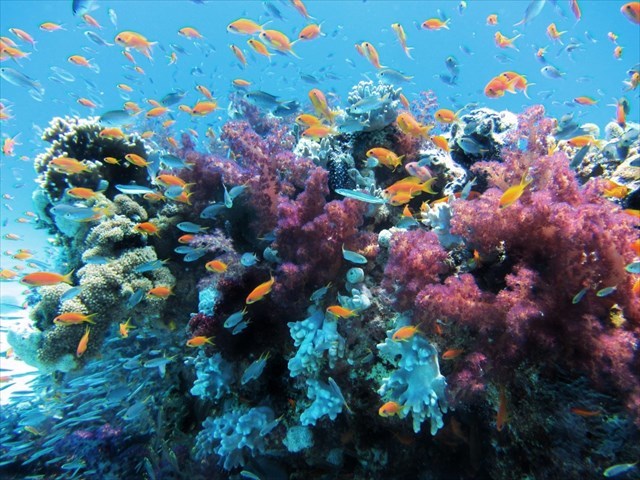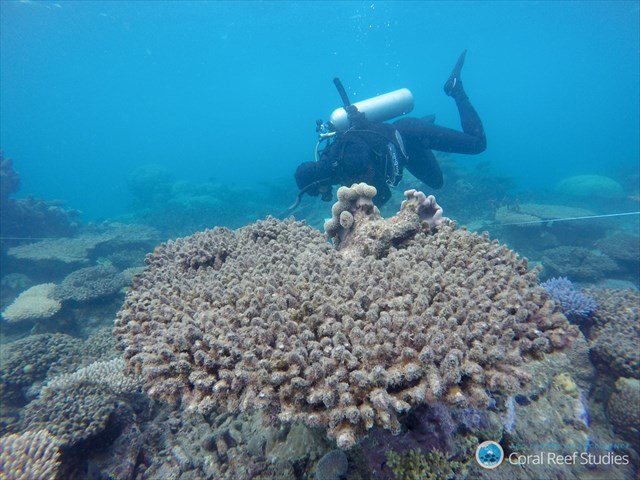

חוף האלמוגים של אילת משתרע על שטח של 1,2 ק"מ מהחוף והוא שונית האלמוגים הרדודה ביותר בעולם. רישום EarthCache זה מחייב מבקרים לבצע משימות ספציפיות לאתר. ראה מידע נוסף על הנושא ועל דרישות הרישום שלהלן.

שוניות האלמוגים בריא צבעוני ומלא חיים.
מה הם שוניות האלמוגים?
שוניות אלמוגים הן מערכות אקולוגיות מתחת למים המכונה גם "יערות הגשם של הים". רוב שוניות האלמוגים נוצרו לאחר התקופה הקרחית האחרונה פחות מ -10 000 שנה, כאשר קרח נמס גרם גובה פני הים לעלות.
שוניות אלמוגים בנויים על ידי פוליפים אלמוגים כפי שהם יוצרים שכבות של סידן פחמתי מתחת לגופם. פוליפים להאריך את זרועותיהם בלילה ללכוד זואופלנקטון ודגים קטנים לעכל אותו בבטן שלהם. האלמוגים הבונים שוניות ידועים כאלמוגים "קשים" או "שוניות". אלמוגים רכים, כגון מאווררי ים וים, אינם מייצרים שוניות. הם אורגניזמים גמישים ללא שלד ולפעמים דומים צמחים או עצים.
הפוליפים מציעים מקלט למינים החיים מתחת למים ויוצרים הרבה אנרגיה אלמוגים באמצעות פוטוסינתזה. אצות קורליין, החיים בתוך רקמות האלמוגים, משתמשות בפוטוסינתזה לייצור חומרים מזינים, רבים מהם הם עוברים לתאי האלמוגים. האלמוגים בתורו פולטים מוצרי פסולת בצורת אמוניום, אשר אצות צורכים כמו חומר מזין. כאשר פוליפים מתים, הם משמשים יסודות לאלמוגים חדשים, בהם האצות החדשות ממשיכות לספק פונקציות אקולוגיות חיוניות כגון ייצוב של מבנה שונית, ייצור של חולות טרופיים ושימור חומרים מזינים ומיחזור.
מדענים בדרך כלל מחלקים שוניות קולר לארבע קבוצות:
1) שוניות פרינגינג
2) שוניות מחסום
3) אטולים
4) שוניות תיקון
ריף שוניות לגדול ליד קו החוף סביב איים ויבשות. הם מופרדים מהחוף על ידי לגונות צרות והם הסוג הנפוץ ביותר של שונית שאנו רואים. שוניות המחסום מקבילות גם לקו החוף, אך הן מופרדות על ידי לגונות עמוקות וגדולות יותר. בנקודה הרדודה ביותר שלהם, הם יכולים להגיע אל פני המים המרכיבים "מחסום" לניווט. אטולים הם טבעות של אלמוגים שיוצרים לגונות מוגן ממוקמים בדרך כלל באמצע הים. אטולים נוצרים כאשר איים מוקפים בשוניות מטורפות שוקעים לים או בגובה פני הים עולה סביבם, בעוד שוניות ממשיכות לצמוח ולבסוף יוצרים עיגולים עם לגונות בפנים. שוניות תיקון הן שוניות קטנות, מבודדות שגדלות מהתחתית הפתוחה של פלטפורמת האי או המדף היבשתי. הם בדרך כלל מתרחשים בין שוניות פרינגינג לבין שוניות מחסום להשתנות מאוד בגודל. לעתים רחוקות מאוד שוניות תיקון להגיע אל פני המים.
איפה אלמוגים לחיות?
אלמוגים מעדיפים מים צלולים ורדודים, שבהם הרבה אור השמש מסתנן לאצות הסימביוטיות שלהם. יותר מדי חומר תלוי מרחף במים חוסם את אור השמש הדרוש לפוטוסינתזה של האצות. הטמפרטורה האופטימלית עבור רוב שוניות האלמוגים הוא 26-27 ° C (79-81 ° F). ניתן למצוא שוניות אלמוגים בעומקים של עד 90 מטרים, אבל אלמוגים לבניית שונית לגדול גרוע מתחת 18-27 מטרים.
אלמוגים צריכים מים מלוחים כדי לשרוד, כך שהם בקושי שורדים ליד פתחי הנהר. רוב השוניות ממוקמות בין הטרופיים של סרטן וגדי, באוקיינוס השקט, באוקיינוס ההודי, בים הקריבי, בים האדום ובמפרץ הפרסי. אלמוגים נמצאים גם בפלורידה ובדרום יפן. למרות ששוניות האלמוגים הן בקושי 0,1% מהאוקיאנוס, למעלה מ -25% מהחיות של האוקיינוס משגשגים שם.
מה גורם להרס שונית האלמוגים?
דיג יתר הורס את בית הגידול הטבעי של שוניות האלמוגים. במיוחד תחתית trawling הוא אחד האיומים הגדולים ביותר על שוניות אלמוגים באזורים עם מים קרים. תיירות חסרת ערך כמו שייט, צלילה ושנורקלינג, אנשים נוגעים בשוניות, מעוררים משקעים ואיסוף אלמוגים פולשים למגוון הביולוגי של אלמוגים, שלא לדבר על פסולת עירונית ותעשייתית, כרייה תעשייתית, אגרוכימיה וזיהום נפט. מזהמים מסוימים, כמו נגר ממגזר החקלאות, מגבירים את רמת החנקן במי-ים וחוסמים את הפוליפים הגורמים לגידול של אצות.
אמנם, שוניות האלמוגים במפרץ אילת נראה עמיד במיוחד להתחממות כדור הארץ, אלמוגים לא יכולים לשרוד אם טמפרטורת המים גבוהה מדי. שינוי האקלים לבדו כבר הוביל אלמוגים הלבנה מאסיבי, כמו שונית המחסום הגדולה של אוסטרליה, ואת הנזק צפוי להגדיל תדירות וחומרה.
אלמוגים פגומים להתאושש לאט, ולכן התנאים שוניות צריך להיות אופטימלי שימור הטבע בעדיפות גבוהה בעשורים הקרובים. אם אבד אצות הוא ממושך ואת הלחץ ממשיך, אלמוגים מת בסופו של דבר.

הלבנה מתרחשת כאשר שוניות הגוסס איבדו לאיטיות את אצותיהם ולבסוף הופכות לבנות.
להיכנס אל הג'וקאצ'ה הזאת
שלח את התשובות לשאלות הבאות כדואר אלקטרוני או באמצעות הודעה. אין צורך להמתין לאישור כניסה. אני אודיע לך, אם התשובות שלך בחלק לא נכון.
1. רשום את הסביבה והחיים העירוניים באילת. רשימת לפחות שלוש סיבות מדוע אלמוגים נוטים לשרוד כאן. באיזו דרך כבר שמרו המקומיים את השוניות השבריריות האלה?
2. עבור אל החוף בקואורדינטות נתון. אם יש לך הזדמנות לצלול או לשנרקל, איך נראית שונית אלמוגים עכשיו? איזה סוג של שונית אתה רואה? אנא, זכור לא לגעת אלמוגים במים. או האם אתה מוצא עצמות אלמוגים ישנות על החוף? אם כן, לתאר את צבעם, גודלם ומשטחם.
אופציונלי: צלם תמונה שלך ו / או התקן ה- GPS בקואורדינטות הנתונות וצרף אותה ליומן.

Eilat's Coral Beach covers 1,2 kilometers of shore and is the northernmost shallow water coral reef in the world. Logging this EarthCache requires visitors to undertake site-specific tasks. See more information about the topic and logging requirements below.

Healthy coral reefs are colorful and full of life.
What are coral reefs?
Coral reefs are underwater ecosystems also called as "rainforests of the sea". Most coral reefs were formed after the last glacial period less than 10 000 years ago, when melting ice caused sea level to rise.
Coral reefs are built by coral polyps as they form layers of calcium carbonate beneath their bodies. Polyps extend their tentacles at night and capture zooplankton and small fish to digest it in their stomachs. The corals that build reefs are known as “hard” or “reef-building” corals. Soft corals, such as sea fans and sea whips, do not produce reefs. They are flexible organisms without skeleton and sometimes resemble plants or trees.
The polyps offer shelter to the species living underwater and create lots of energy to the corals through photosynthesis. The coralline algae, that live inside the corals' tissues, use photosynthesis to produce nutrients, many of which they pass to the corals' cells. The corals in turn emit waste products in the form of ammonium, which the algae consume as a nutrient. When polyps die, they serve as foundations for new corals, in which the new algae continue to provide vital ecological functions such as stabilization of reef structure, production of tropical sands and nutrient retention and recycling.
Scientists generally divide colar reefs into four classes:
1) fringing reefs
2) barrier reefs
3) atolls
4) patch reefs
Fringing reefs grow near the coastline around islands and continents. They are separated from the shore by narrow lagoons and are the most common type of reef that we see. Barrier reefs also parallel the coastline but are separated by deeper and wider lagoons. At their shallowest point, they can reach the water’s surface forming a “barrier” to navigation. Atolls are rings of coral that create protected lagoons and are usually located in the middle of the sea. Atolls form when islands surrounded by fringing reefs sink into the sea or the sea level rises around them, while reefs still continue to grow and eventually form circles with lagoons inside. Patch reefs are small, isolated reefs that grow up from the open bottom of the island platform or continental shelf. They usually occur between fringing reefs and barrier reefs and vary greatly in size. Very rarely patch reefs reach the surface of the water.
Where corals live?
Corals prefer clear and shallow water, where lots of sunlight filters through to their symbiotic algae. Too much suspended material floating in the water blocks the sunlight necessary for the algae's photosynthesis. The optimum temperature for most coral reefs is 26–27 °C (79–81 °F). It is possible to find coral reefs at depths of up to 90 meters, but reef-building corals grow poorly below 18–27 meters.
Corals need salt water to survive, so they hardly survive near river openings. Most reefs are located between the Tropics of Cancer and Capricorn, in the Pacific Ocean, the Indian Ocean, the Caribbean Sea, the Red Sea and the Persian Gulf. Corals are also found in Florida and southern Japan. Though coral reefs make up barely 0,1 percent of the ocean, over 25 percent of the ocean's animals thrive there.
What causes coral reef destruction?
Over-fishing destroys coral reef's natural habitat. Especially bottom-trawling is one of the greatest threats to coral reefs in areas with cold water. Careless tourism such as boating, diving and snorkeling, with people touching reefs, stirring up sediment and collecting coral invades coral's biodiversity, not to mention urban and industrial waste, industrial mining, agrochemicals and oil pollution. Some pollutants such as runoff from farming increase the level of nitrogen in seawater and block the polyps causing an overgrowth of algae.
Although, coral reefs in the Gulf of Eilat seem to be particularly resistant to global warming, corals cannot survive if the water temperature is too high. Climate change alone has already led to corals bleaching massively, as in Australia's Great Barrier Reef, and damage is predicted to increase in frequency and severity.
Damaged coral recover slowly, thus the reefs’ conditions should be optimal and nature conservation a high priority in the coming decades. If the algae loss is prolonged and the stress continues, coral eventually dies.

Bleaching occurs when the dying reefs slowly lost their algae and finally turn white.
TO LOG THIS GEOCACHE AS FOUND
Send your answers to the following questions via Message Center. You don't have to wait for a logging permission. I'll let you know, if your answers are in some part incorrect.
1. List at least three reasons why corals tend to survive here. In what way the locals have already preserved these fragile reefs?
2. Go to the beach at given coordinates. What type of reef do you think Eilat Coral forms? If you have a chance to scuba dive or snorkel, describe how does the coral reef look now. Please, remember NOT to touch the coral in the water. Alternatively, look for old coral bones at the beach and describe their colour, size and surface. In case the entrance to the beach is closed, you may find your answers at the nearby Underwater Observatory.
OPTIONAL: Take a picture of you and/or your GPS device at the given coordinates and attach it into your log.
If preferred, you may also answer these questions in Finnish.